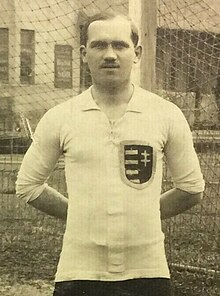Imre Schlosser
 | |||
| Personal information | |||
|---|---|---|---|
| Full name | Imre Schlosser-Lakatos | ||
| Date of birth | 11 October 1889 | ||
| Place of birth | Budapest, Kingdom of Hungary | ||
| Date of death | 18 July 1959 (aged 69)[1] | ||
| Place of death | Budapest, Hungary | ||
| Position(s) | Forward | ||
| Senior career* | |||
| Years | Team | Apps | (Gls) |
| 1905–1916 | Ferencvárosi TC | 155 | (258) |
| 1916–1922 |
MTK Hungária FC | 125 | (141) |
| 1925–1926 | Wiener AC | 17 | (6) |
| 1926–1927 | Ferencvárosi TC | 14 | (11) |
| 1927–1928 | Budai 33 | 9 | (1) |
| Total | 320 | (417) | |
| International career | |||
| 1906–1927 | Hungary | 68 | (59) |
| Managerial career | |||
| 1922–1923 | Vívó és Atlétikai Club | ||
| 1923–1924 | IFK Norrköping | ||
| 1924–1925 | Wisła Kraków | ||
| 1925–1926 | Wiener AC | ||
| 1925–1926 | Brigittenauer AC | ||
| *Club domestic league appearances and goals | |||
Imre Schlosser (also known as Imre Lakatos; 11 October 1889 – 18 July 1959) was a Hungarian footballer of Danube Swabian ancestry who played as a forward. He still holds the record as the highest goalscorer in the history of the Hungarian National Championship. He was also the first player from outside the British Isles to break the record of most association football international caps.
Club career
The son of János Schlosser and Mária Kettner, he had two elder brothers, János and József, who were both members of
International career
Schlosser made his debut for
Schlosser was the first footballer to score 50 international goals,[10] achieving the feat when he scored a brace (two goals) in a 6–2 victory against Austria on 3 June 1917.
International
Sources:[11]
| Hungary national team | ||
|---|---|---|
| Year | Apps | Goals |
| 1906 | 2 | 1 |
| 1907 | 4 | 0 |
| 1908 | 4 | 3 |
| 1909 | 5 | 7 |
| 1910 | 3 | 2 |
| 1911 | 7 | 12 |
| 1912 | 10 | 16 |
| 1913 | 3 | 1 |
| 1914 | 5 | 3 |
| 1915 | 4 | 2 |
| 1916 | 3 | 2 |
| 1917 | 5 | 4 |
| 1918 | 4 | 3 |
| 1919 | 1 | 0 |
| 1920 | 1 | 0 |
| 1921 | 4 | 2 |
| 1926 | 2 | 0 |
| 1927 | 1 | 0 |
| Total | 68 | 58 |
Honours
Ferencvárosi TC
- Challenge Cup: 1908-09
MTK Hungária FC
Individual
- Hungarian Top Scorer: 1909, 1910, 1911, 1912, 1913, 1914, 1917
- European Top Scorer: 1911, 1912, 1913, 1914[12]
See also
- List of men's footballers with 50 or more international goals
- List of footballers with 500 or more goals
References
- Olympedia
- ^ "Ferencvárosi TC - Budapesti AK 2 : 1, 1913.06.01". magyarfutball.hu. Retrieved 29 May 2022.
- ^ "European Topscorers by Season". Rec.Sport.Soccer Statistics Foundation. Retrieved 26 May 2022.
- ^ "Best League Goalscorers All-Time". Rec.Sport.Soccer Statistics Foundation. Retrieved 29 May 2022.
- ^ "Magyar Életrajzi Lexikon 1000–1990". www.mek.iif.hu.
- ^ "Imre Schlosser-Lakatos - Goals in International Matches". Rec.Sport.Soccer Statistics Foundation. Retrieved 29 May 2022.
- ^ "Imre Schlosser". football.eu. Retrieved 29 May 2022.
- ^ "Olympic Football Tournament Stockholm 1912". FIFA website. Archived from the original on 4 August 2020. Retrieved 29 May 2022.
- ^ "V. Olympic Games Consolation Tournament 1912 results". football.eu. Retrieved 29 May 2022.
- ^ "The Top 50 International Goalscorers of All Time". Sport Illustrated. Archived from the original on 19 July 2019. Retrieved 9 September 2020.
- ^ "Imre Schlosser-Lakatos - Goals in International Matches". RSSSF. 2 February 2021. Retrieved 12 June 2022.
- ^ "European Topscorers before 1967/68". Rec.Sport.Soccer Statistics Foundation. 10 September 2005. Retrieved 29 May 2022.
